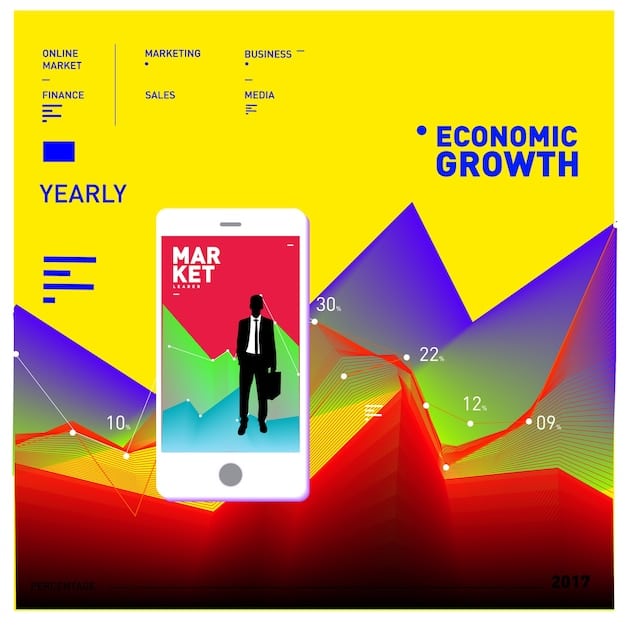Profit from K-Drama OSTs: Your 2025 Investment Guide

Korean Drama OST investments offer a unique and potentially lucrative avenue for music enthusiasts and savvy investors to capitalize on the global surge in K-drama popularity, leveraging strategic financial models and market analytics for significant returns by 2025.
The global phenomenon of Korean Dramas, or K-Dramas, has captivated millions, transcending cultural barriers and creating a massive wave of dedicated fans. Beyond compelling storylines and charismatic actors, one element consistently stands out: the Original Soundtracks, or OSTs. These musical masterpieces are not just background scores; they are integral to the K-Drama experience, often becoming as popular as the dramas themselves. For those seeking innovative ways to diversify their portfolios, exploring Korean Drama OST Investments: How to Profit from Soundtracks in 2025 might just be the next big opportunity. This guide delves into the burgeoning market of K-Drama OSTs, offering insights into their valuation, potential for growth, and strategies to turn your passion into profit.
The Surging Value of Korean Drama OSTs
K-Drama OSTs are no longer mere accompaniments to television series; they have evolved into a significant cultural and economic force. The global rise of Hallyu, the Korean Wave, has propelled K-content to unprecedented heights, and its soundtracks are riding this wave. These songs often feature renowned K-pop idols or established ballad singers, lending them immediate credibility and a pre-existing fanbase. The emotional resonance of these tracks, deeply woven into the narrative fabric of the dramas, creates a powerful connection with listeners, driving repeat streams and purchases long after a drama concludes.
The demand for K-Drama OSTs is quantifiable. Digital streaming platforms report billions of plays, and physical album sales, often including exclusive photo cards or memorabilia, continue to soar. This sustained interest transforms OSTs from transitory entertainment into enduring intellectual property with tangible value. Understanding this market shift is crucial for anyone considering investment opportunities, as it highlights a consistent and growing consumer base.
The Global Impact and Digital Footprint
The global impact of K-Drama OSTs is undeniable, driven largely by digital platforms. Services like Spotify, Apple Music, and YouTube have made these soundtracks accessible to a worldwide audience, breaking down geographical barriers and fostering a truly global legion of fans. This digital accessibility means that a hit OST can achieve viral status overnight, generating significant revenue through streaming royalties and digital downloads.
- Broad Reach: K-Drama OSTs are consumed globally, from Asia to the Americas and Europe.
- Streaming Dominance: Digital platforms are the primary drivers of listenership and revenue.
- Viral Potential: A song tied to a popular drama can quickly become a global hit.
Moreover, the virality of K-Drama moments, often amplified by social media, directly fuels the popularity of their accompanying OSTs. Memorable scenes become intrinsically linked with their musical backdrops, prompting viewers to seek out the full tracks. This organic marketing loop ensures a continuous cycle of discovery and consumption, underpinning the financial viability of these musical assets.
Investing in K-Drama OSTs means recognizing their dual appeal: as standalone musical works and as extensions of immensely popular visual narratives. Their continuous engagement metrics across various platforms signify a market ripe for various investment strategies, from catalog acquisitions to royalty participation. The intrinsic value of these musical assets, bolstered by a fervent global fanbase, paints a promising picture for future profitability.
The consistent global reach and strong digital footprint of K-Drama OSTs make them attractive assets for investment. Their ability to generate sustained revenue through streaming and digital sales, coupled with an ever-expanding fanbase, points to a robust and growing market. The intertwined nature of the music with the drama's success creates a symbiotic relationship crucial for understanding their long-term investment potential.
Identifying High-Value OSTs for Investment in 2025
Identifying high-value K-Drama OSTs for investment requires a discerning eye and a deep understanding of market dynamics beyond simple popularity. While a drama’s immediate success offers a good starting point, discerning long-term value involves analyzing several critical factors. Potential investors must look beyond immediate charting success and consider the enduring appeal of both the drama and its musical components.
Key metrics and trends can guide this selection process. This includes examining the cast’s star power, as actors and actresses with large fanbases can significantly boost an OST’s initial traction. Furthermore, the reputation of the music director, known composers, and featured vocalists also plays a crucial role. A track penned by a celebrated songwriter or performed by a top-tier idol typically carries a higher intrinsic value and a greater likelihood of sustained listenership.
Analytics and Market Indicators
To accurately identify high-value OSTs, investors should delve into specific analytics and market indicators. These data points offer quantifiable insights into potential future performance.
- Streaming Performance: Analyze historical streaming data across major platforms for similar OSTs. Look for consistent listenership rather than just peak popularity.
- Social Media Engagement: Tracks that generate significant discussion, fan covers, and challenges on platforms like TikTok and Instagram often have stronger viral potential and longevity.
- Fan Community Strength: Active and loyal fan bases of the drama, the artists involved, and the genre itself indicate sustained interest and purchasing power.
Moreover, consider the thematic relevance and universal appeal of the songs. OSTs that resonate with diverse audiences, regardless of cultural background, tend to have a longer shelf life and broader market reach. While specific dramas may have niche appeal, their soundtracks can often transcend these boundaries through their musical quality and emotional depth.
Another crucial aspect is the potential for synchronization licensing. A well-composed OST can be licensed for commercials, films, or other media, generating additional revenue streams beyond initial release royalties. This diversification of income potential significantly enhances an OST’s overall investment appeal, transforming it into a multi-faceted asset rather than a singular revenue source.
By meticulously researching these factors, investors can move beyond speculative guesses and make informed decisions on which K-Drama OSTs offer the most promising returns in the long run. The combination of artistry, star power, and measurable digital engagement provides a robust framework for identifying truly high-value investment opportunities in this unique market.

Investment Avenues: How to Purchase K-Drama OST Royalties
Investing in K-Drama OSTs isn’t as straightforward as buying stocks, but various emerging avenues allow for participation in their profitability. The most direct and potentially lucrative method is acquiring a share of the song’s royalties. This means owning a portion of the future earnings generated each time the song is streamed, downloaded, broadcast, or licensed. This model has gained traction in the broader music industry and is increasingly applicable to the niche yet powerful K-Drama OST market.
Several platforms specialize in music royalty investments, acting as marketplaces where artists or rights holders can sell fractional ownership of their catalogs. While many of these traditionally focus on established Western artists, the growing global appeal of K-content means that more of these platforms are beginning to list K-Drama OSTs or are open to expanding into this segment. Investors need to carefully research these platforms, understanding their fee structures, the types of rights being sold (e.g., master recordings, publishing royalties), and their due diligence process.
Platforms and Considerations for Royalty Acquisition
The landscape for music royalty investments is evolving, but several models facilitate the acquisition of K-Drama OST royalties.
- Direct Rights Acquisition: For high-net-worth individuals or firms, directly negotiating with production companies or music labels for a percentage of an OST’s future royalties is possible, though it requires significant capital and legal expertise.
- Music Royalty Marketplaces: Platforms such as Hipgnosis Songs Fund (though focused on major artists, their model indicates possibilities), Royalty Exchange, or private equity firms specializing in music assets might eventually broaden their scope to include more K-Drama OSTs as the market matures and proves its profitability.
- Crowdfunding/Fractional Ownership Platforms: Some newer platforms are exploring fractional ownership of music royalties, allowing smaller investors to pool resources. This democratizes access but often comes with higher platform fees and less control.
Before committing, it’s crucial to understand the nuances of music royalties. There are typically two main types: publishing royalties (earned from the composition of the song) and master recording royalties (earned from the actual sound recording). An investment might grant access to one or both. The terms of the deal—the percentage of royalties, the duration of ownership, and any potential buy-back clauses—are paramount.
Furthermore, due diligence involves scrutinizing the historical earnings of the specific OST or similar tracks from the same production company or artists. Understanding the royalty payout schedule, transparency of reporting, and the legal framework governing these investments is vital. The regulatory environment for music royalty investments can vary, so seeking legal and financial advice is highly recommended to mitigate risks and ensure a clear understanding of the investment’s nature and potential returns.
As the K-Drama market continues its global expansion, the infrastructure for investing in its musical assets is likely to become more robust and accessible. Early adopters who navigate these complex investment avenues wisely could stand to benefit significantly from the enduring appeal and financial growth of K-Drama OSTs.
Risk Assessment and Due Diligence in OST Investments
Like any investment, K-Drama OST acquisitions come with inherent risks that must be thoroughly assessed. While the market shows strong potential, a nuanced understanding of these risks is crucial for mitigating losses and ensuring a sustainable investment strategy. Blindly following popularity trends can lead to poor decisions, as not all popular OSTs translate into consistent, long-term revenue streams.
One primary risk is the unpredictable nature of entertainment trends. While K-Dramas are currently booming, tastes can shift. A drama that is immensely popular today might not retain the same cultural relevance or viewership in five or ten years, directly impacting the sustained listenership of its OST. Furthermore, the longevity of an OST can be influenced by factors beyond the drama itself, such as public perception of the artists involved or changes in music consumption habits.
Mitigating Risks and Essential Due Diligence Steps
Effective risk mitigation in K-Drama OST investments hinges on thorough due diligence.
- Diversification: Do not put all your investments into a single OST. Diversify across various dramas, artists, genres, and even different types of music assets within the K-content sphere to spread risk.
- Future-Proofing Royalties: Investigate how royalty income is calculated and distributed. Ensure the agreements are transparent regarding digital streaming platforms, international licensing, and potential future uses of the music.
- Legal Scrutiny: Have legal experts review all contracts related to royalty acquisition. Understand who holds the master rights, publishing rights, and any sublicensing agreements. Verify the chain of title for the intellectual property.
Another significant consideration is the regulatory environment surrounding music royalties. Different countries have varying laws regarding intellectual property, copyright duration, and royalty collection. As K-Drama OSTs have a global reach, understanding these international legal frameworks is essential for ensuring that royalties are collected efficiently and repatriated correctly. Tax implications on international earnings also need careful consideration, as they can significantly impact net returns.
The potential for disputes over ownership or royalty shares is another risk. The music industry can be complex, with multiple parties (composers, lyricists, performers, labels, production companies) often having a claim to a song’s earnings. Clear contractual agreements that delineate each party’s share and responsibilities are paramount. Investors should only proceed when there’s an unambiguous chain of ownership and a robust system for tracking and distributing royalties.
By approaching K-Drama OST investments with a comprehensive risk assessment framework and an unwavering commitment to due diligence, investors can navigate this exciting but intricate market more confidently. A proactive and informed approach will be the cornerstone of successful, profitable ventures in the dynamic world of K-Drama soundtracks.
Forecasting Returns: What to Expect by 2025
Predicting exact returns on any investment is inherently challenging, and K-Drama OSTs are no exception. However, by analyzing current trends, market growth projections, and the unique characteristics of this niche, we can establish realistic expectations for profitability by 2025. The general outlook is positive, driven by the continued global expansion of Hallyu and the increasing sophistication of music monetization platforms.
The primary driver of returns will continue to be digital streaming. As subscription numbers for platforms like Spotify, Apple Music, and YouTube Premium grow globally, the total pool of royalty payments expands. For established K-Drama OSTs, this means a sustained, long-term revenue stream. New releases tied to anticipated dramas can expect significant initial surges in streams, with longevity determined by the drama’s enduring popularity and the song’s intrinsic appeal. Forecasts suggest a continued upward trajectory for digital music revenue, directly benefiting royalty holders.
Key Factors Influencing Profitability
Several critical factors will dictate the magnitude of returns on K-Drama OST investments by 2025.
- Hallyu Expansion: The growth of K-Drama viewership into new markets directly translates to new listeners for OSTs. Regions previously less exposed to K-content represent untapped revenue potential.
- Monetization of Ancillary Rights: Beyond streaming, increased licensing for commercials, video games, or other media can create additional revenue streams. The more versatile and recognizable an OST, the greater its potential for such opportunities.
- Fan Engagement and Merchandising: The strong K-Drama fanbase often supports artists through official merchandise and concert attendance (when possible), indirectly boosting the overall value proposition of their musical works.
The long tail effect of streaming is particularly pertinent to OSTs. Unlike radio hits that quickly fade, a K-Drama with enduring popularity can ensure its OSTs are discovered and re-listened to for years. This creates a compounding effect, where initial investments continue to generate income long after the drama’s release. By 2025, many OSTs from dramas released in the early 2020s are expected to have settled into a predictable, consistent earnings pattern, making them attractive for long-term holders.
However, investors should temper expectations with realism. Returns are unlikely to be exponential year after year, especially for older catalogs. Instead, aim for steady, predictable growth, potentially outpacing traditional fixed-income investments. The key is identifying OSTs with proven longevity and a broad, active fanbase that will continue to drive engagement and, consequently, royalty payments. A diversified portfolio, combining both new and established OSTs, can offer a balanced risk-reward profile for those looking to profit from this vibrant market.

Beyond Royalties: Other Potential Investment Opportunities
While royalty acquisition remains the most direct route to profiting from K-Drama OSTs, the expansive K-content ecosystem offers several ancillary investment opportunities. These avenues might not involve direct ownership of music rights but leverage the immense popularity of OSTs and the cultural phenomena they represent. Exploring these broader opportunities allows investors to tap into different facets of the market, potentially diversifying their portfolio and capitalizing on related growth trends.
One such area is content creation and distribution platforms focusing on K-Dramas and their music. Investments in streaming services that heavily feature K-content, or even specialized platforms for K-music, could yield returns as the audience expands. These platforms benefit directly from increased viewership and listenership, providing a broader exposure to the entire K-entertainment industry rather than just individual songs.
Related Investment Opportunities in the K-Content Ecosystem
Broadening the investment scope beyond direct OST royalties can uncover additional profitable ventures.
- K-Pop/K-Drama Related Merchandise: OSTs often lead to demand for related merchandise, such as vinyl records, special edition albums, or official drama-themed goods. Investing in companies that produce or distribute these items could be lucrative.
- Fan Engagement Platforms: Investing in tech companies or platforms that facilitate global fan engagement with K-Dramas and their artists (e.g., social media tools, fan community apps, virtual event platforms) capitalizes on the active and dedicated fanbase.
- Production Companies: A more hands-on approach could involve investing in the K-Drama production companies themselves. Successful dramas drive successful OSTs, making an investment in the source material a potentially impactful long-term play.
Another fascinating area is the live performance and concert segment. While not directly investing in OSTs, supporting or investing in companies that organize K-Drama OST concerts or fan meets (where OST singers perform) can be highly profitable. These events capitalize on the emotional connection fans have with the music and provide a unique live experience, generating ticket sales and merchandise revenue.
Furthermore, consider the technology used in music production and distribution within Korea. Investments in sound engineering firms, digital distribution companies, or even start-ups developing innovative music consumption technologies could indirectly benefit from the overall boom in K-music, including OSTs. This offers a more technological and infrastructure-focused investment approach, less reliant on individual song performance.
By looking beyond traditional royalty investments and exploring these adjacent opportunities, investors can build a more robust and diversified portfolio within the dynamic K-content market. These diversified strategies can offer both direct and indirect benefits from the sustained global passion for Korean dramas and their unforgettable soundtracks, maximizing the potential for significant returns by 2025.
Navigating the Future: AI, Technology, and K-Drama OSTs
As we look towards 2025 and beyond, the intersection of advanced technology, particularly Artificial Intelligence (AI), with the K-Drama OST market presents both opportunities and challenges. AI is rapidly transforming the music industry, from composition and production to promotion and royalty tracking. Understanding these technological shifts is crucial for any investor seeking to future-proof their K-Drama OST portfolio and maximize profitability in an evolving landscape.
AI’s role in music creation is expanding, with algorithms capable of generating melodies, harmonies, and even full instrumental tracks. While human creativity remains paramount, AI tools can assist composers, potentially accelerating the production of OSTs and providing new sonic possibilities. For investors, this could mean faster turnover of music content and potentially more consistent releases of new OSTs, increasing the overall volume of valuable assets in the market.
The Impact of Emerging Technologies on OST Investments
The ongoing advancement of technology will profoundly influence the K-Drama OST investment landscape.
- AI-Powered Analytics: Advanced AI can provide more precise predictions for an OST’s success based on intricate data analysis (listener behavior, genre trends, artist popularity), guiding investment decisions with greater accuracy.
- Blockchain for Royalty Transparency: Blockchain technology offers a decentralized ledger for tracking music rights and royalty payments. This could revolutionize transparency in ownership and distribution, reducing disputes and ensuring more equitable and efficient payouts for investors.
- Immersive Fan Experiences: Technologies like virtual reality (VR) and augmented reality (AR) could create new avenues for fan engagement with OSTs, such as virtual concerts or interactive drama experiences featuring the music. These new consumption models could generate additional revenue streams.
However, AI also presents challenges, particularly concerning intellectual property. As AI-generated music becomes more sophisticated, questions surrounding authorship and ownership of royalties will become increasingly complex. Investors need to be aware of how these legal frameworks might evolve and ensure that their agreements clearly define ownership in the context of AI-assisted creation. The potential for ‘deepfake’ music or AI-driven voice synthesis could also muddy the waters regarding genuine artist performances.
Furthermore, the relentless pace of technological innovation means that platforms and consumption methods can change rapidly. While streaming is dominant now, new forms of music consumption (e.g., metaverses, interactive soundscapes) may emerge, creating new revenue models that investors must adapt to. Staying informed about these technological shifts and their potential impact on royalty collection and distribution is vital for long-term success.
By embracing these technological advancements and understanding their implications, investors can strategically position themselves to benefit from the ongoing evolution of the K-Drama OST market. The future of OST investments is intertwined with innovation, offering exciting prospects for those willing to navigate the digital frontier alongside the captivating melodies of K-Dramas.
Building a Sustainable K-Drama OST Investment Portfolio
Building a sustainable K-Drama OST investment portfolio is about more than just picking popular songs; it requires a strategic, long-term approach that balances passion with prudence. As with any specialized market, understanding the nuances of K-content, its fanbase, and the broader music industry is essential. A truly sustainable portfolio will not only seek to maximize immediate returns but also ensure resilience against market fluctuations and evolving trends.
The foundation of a sustainable portfolio lies in diversification. This isn’t limited to investing in multiple OSTs but extends to diversifying across different types of dramas (e.g., romance, historical, fantasy), various musical styles within OSTs (ballads, upbeat tracks, instrumentals), and potentially even different artists. Spreading investments across a wide range of assets helps mitigate risks associated with the underperformance of any single OST or the waning popularity of a specific genre or artist.
Strategies for Long-Term Portfolio Growth
Cultivating a robust K-Drama OST investment portfolio requires a multi-faceted strategy focused on long-term growth and stability.
- Continuous Market Research: Stay abreast of upcoming dramas, new artists, and evolving consumption trends. Understanding what resonates with the global K-Drama audience is key to identifying future high-value assets.
- Understanding Royalty Structures: Deeply understand the royalty payout mechanisms. Prioritize investments where payments are transparent, consistent, and encompass a broad range of income sources (streaming, sync licensing, public performance).
- Networking and Expert Consultation: Connect with industry experts, music analysts, and legal professionals specializing in intellectual property. Their insights can provide invaluable guidance in navigating this complex market.
Furthermore, consider the holding period for your investments. While some may seek quick gains from newly released, highly anticipated OSTs, true sustainability often comes from holding onto assets that demonstrate consistent, long-term earning potential. Many older K-Drama OSTs continue to generate significant passive income years after their release, becoming evergreen assets in a diversified portfolio.
It’s also beneficial to engage with the K-Drama and K-pop communities. Understanding fan sentiment, tracking social media trends, and participating in discussions can provide organic insights that traditional market analytics might miss. This grassroots understanding can offer early indicators of an OST’s potential longevity and cultural impact, which directly translates to its financial value.
Finally, regularly review and rebalance your portfolio. As some OSTs mature and their earnings stabilize, new opportunities will emerge. A sustainable portfolio is not static; it adapts to market changes, sheds underperforming assets, and acquires new ones with strong growth potential. By adopting these comprehensive strategies, investors can transform their appreciation for Korean Drama soundtracks into a consistently profitable and enjoyable investment venture, securing their place in this exciting new market for 2025 and beyond.
| Key Aspect | Brief Description |
|---|---|
| 📈 Market Growth | K-Drama OST market is rapidly expanding due to global Hallyu phenomenon. |
| 💡 Investment Avenues | Primarily through royalty acquisition on specialized music platforms. |
| ⚖️ Risk & Due Diligence | Assess market trends, legal frameworks, and ensure transparency in royalty tracking. |
| 🔮 Future Outlook | Positive, with steady returns driven by digital streaming and global expansion. |
Frequently Asked Questions About K-Drama OST Investments
K-Drama OSTs are Original Soundtracks specifically composed and performed for Korean television dramas. They are valuable because they become deeply intertwined with popular narratives and charismatic artists, commanding billions of streams and significant fan engagement globally, leading to substantial and sustained royalty earnings. Their global reach makes them unique cultural assets with economic leverage.
The primary way to invest is by acquiring a share of their future royalties. This can be done through music royalty marketplaces, direct negotiation with rights holders for larger sums, or potentially via fractional ownership platforms. Thorough due diligence is essential to understand the terms, royalty types (publishing vs. master recording), and historical performance of the asset.
Key risks include the unpredictable nature of entertainment trends, potential shifts in consumer preferences for streaming, and complexities in international royalty collection. Legal disputes over ownership and transparency issues in payment distribution are also concerns. Diversification across multiple OSTs and thorough legal review of contracts can help mitigate these risks.
By 2025, you can expect steady, predictable growth, primarily driven by continued digital streaming across global platforms. Returns are unlikely to be exponential but can offer competitive yields compared to traditional investments. The longevity of a drama’s popularity and the song’s overall appeal will significantly influence the rate of return, aiming for consistent, long-term income.
Yes, beyond direct royalty investments, you can explore opportunities in related sectors. This includes investing in K-Drama or K-music streaming platforms, companies producing K-content merchandise, live event organizers for OST concerts, or even K-Drama production companies themselves. These provide diversified exposure to the broader, thriving K-entertainment ecosystem.
Conclusion
Investing in K-Drama OSTs represents a compelling and increasingly viable opportunity for those looking to diversify their investment portfolios in 2025. Fueled by the undeniable global expansion of Hallyu, these soundtracks transcend mere background music, establishing themselves as standalone cultural and economic powerhouses. While requiring diligent research and a strategic approach to navigate the nuances of royalty acquisition and intellectual property, the potential for sustained returns through digital streaming and ancillary licensing remains significant. For the informed investor, the melodies of K-Dramas offer not just emotional resonance but a promising path to financial growth within the dynamic world of global entertainment.





